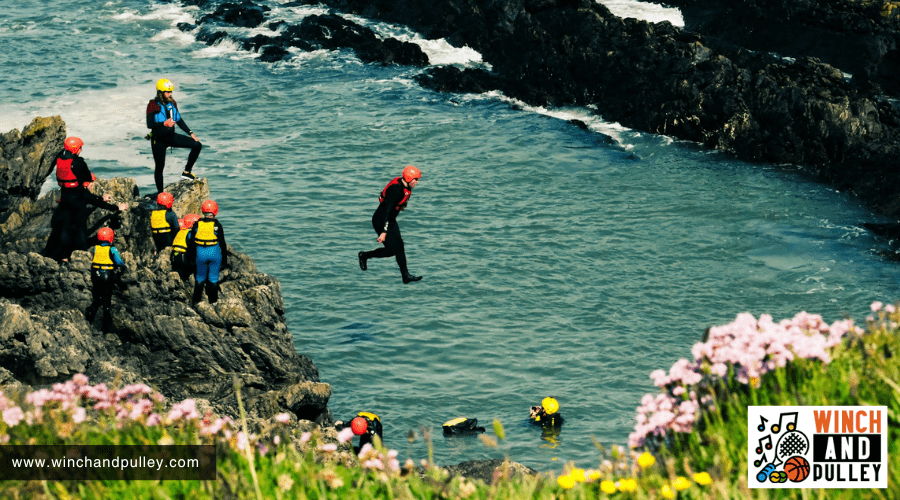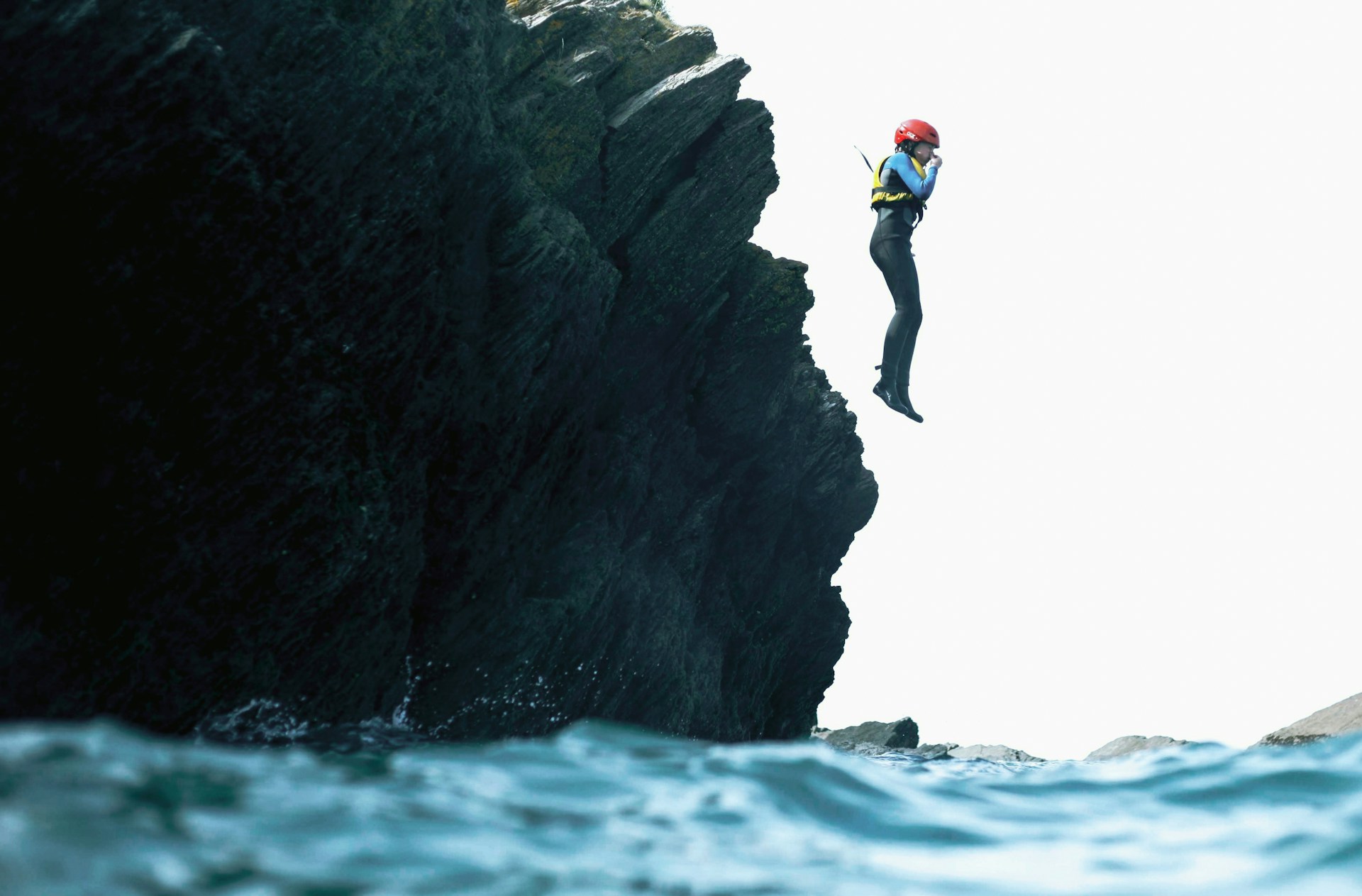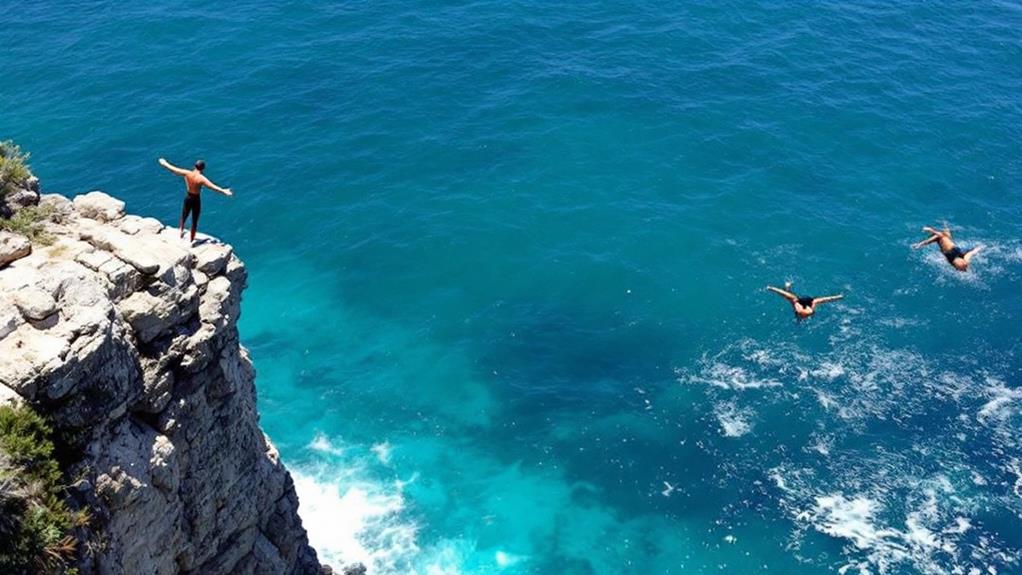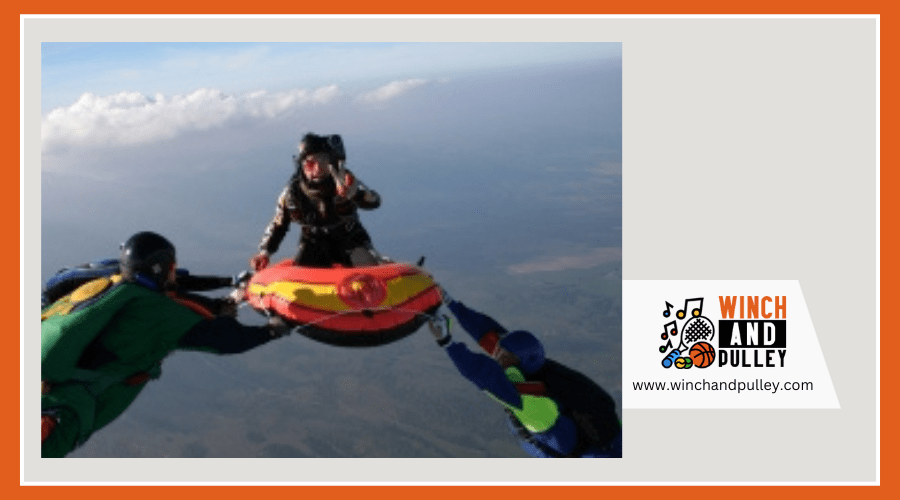Coasteering: Climbing, Swimming, and Diving Along Coastlines

Imagine traversing rugged coastlines, climbing jagged rocks, swimming through dynamic waters, and diving into the sea—all in one exhilarating adventure. Coasteering, an activity that originated in the UK in the mid-20th century, offers just that experience. With essential safety gear like helmets and life jackets, you can explore sea caves and tackle challenging terrains.
But what sets coasteering apart from other outdoor sports? By combining physical exertion with mental resilience, it provides a unique way to connect with nature and push your limits. Ready to discover how to get started?
Key Takeaways
Coasteering blends climbing, swimming, and diving to explore coastal landscapes in a unique way. Essential safety gear includes helmets, life jackets, wetsuits, and specialized water shoes for protection. It is crucial to understand and monitor wave forecasts and tides for a safe coasteering experience. Effective group coordination involves assigning roles, using hand signals, and establishing a buddy system. Popular coasteering destinations include Mallorca, Ireland's Wild Atlantic Way, and Newquay in the UK.
What Is Coasteering?
Coasteering is an exhilarating adventure sport that combines swimming, climbing, and diving along rugged coastlines. It offers a thrilling mix of activities that allow you to explore coastal landscapes in a unique way. Imagine navigating through rocky terrain, swimming in the open ocean, and jumping from cliffs into the sea.
Unlike a casual beach walk, coasteering takes you through sea caves, up jagged cliffs, and into crashing waves. This sport gives you access to parts of the coastline that are otherwise unreachable by land or boat.
Safety is paramount, so participants use gear like helmets, life-jackets, and ropes to navigate the challenging environment. Being physically fit is important, as you need to be comfortable on wet surfaces and confident in open water.
Coasteering isn't just about adrenaline; it's about immersing yourself in nature and experiencing the raw beauty of the coastline. By the end of your adventure, you'll have a deeper appreciation for the rugged coastal environments and the thrill of exploring them up close.
History and Origins
Coasteering finds its origins in the early exploration of the UK's rugged coastlines. Officially recognized in the 1980s, it combines climbing, swimming, and sea jumping. Today, coasteering is a popular adventure sport with established safety standards and guidelines, largely due to organizations like the National Coasteering Charter (NCC).
Early Coastal Exploration
British adventurers in the mid-20th century began pioneering the thrilling activity of exploring rugged coastlines by foot, swimming, and climbing. For the first time, explorers navigated areas like Big Pebble Beach, uncovering hidden sea caves that added mystery and excitement to their expeditions. These early explorations laid the foundation for what would eventually become known as coasteering.
Imagine standing on the edge of a jagged cliff, with waves crashing below, ready to plunge into the unknown. That's what these early explorers experienced as they traversed the UK's rocky shores. They relied on their wits and physical prowess, lacking the modern equipment we use today.
Key Points of Early Coastal Exploration:
| Aspect | Details |
|---|---|
| Origin | Mid-20th century, UK |
| Key Locations | Wales, Cornwall, Scotland |
| Initial Sites | Big Pebble Beach, sea caves |
| Methods | Hiking, climbing, swimming |
| Unique Challenges | Wet surfaces, open water, crashing waves |
These early adventurers faced dynamic and unpredictable conditions, making each exploration unique. Their courage and curiosity set the stage for the exhilarating sport of coasteering, transforming the way we interact with coastal landscapes.
Advent of Coasteering

Drawing inspiration from mid-20th century pioneers, coasteering began to take shape along the UK's rugged coastlines. Enthusiasts were eager to explore the untamed beauty of sea caves, cliffs, and open water. The UK's coastline, particularly in Wales, Cornwall, and Scotland, provided the perfect setting for this emerging activity, with its dramatic and challenging terrain.
In its early days, coasteering routes were often informal, discovered through sheer determination and a love for adventure. As climbers, swimmers, and divers combined their skills, they created a unique blend of exploration that distinguished coasteering from similar activities like canyoning, which is focused on inland canyons and gorges.
The activity quickly gained popularity, leading to the establishment of the National Coasteering Charter. This ensured unified industry standards and safety protocols, making coasteering more accessible and secure for everyone.
Through the efforts of passionate adventurers and the allure of the UK's rugged coastline, coasteering evolved into a recognized and beloved outdoor pursuit, blending excitement with nature's raw beauty.
Modern Coasteering Evolution
Evolving from its adventurous roots along the UK's rugged coastlines, modern coasteering has transformed into a structured and popular outdoor activity. The rocky shores of Wales, Cornwall, and Scotland initially provided the perfect backdrop for thrill-seekers to explore sea caves and leap into the ocean. Today, coasteering has grown beyond its beginnings, with the National Coasteering Charter (NCC) ensuring safety and industry standards.
Why has coasteering become so widespread? It's the unique blend of activities and the nature of the coastline that makes it irresistible:
- Diverse Experiences: Coasteering combines climbing, swimming, and diving into one unparalleled adventure.
- Safety Standards: Thanks to the NCC, participants can enjoy coasteering with confidence, knowing that robust safety protocols are in place.
- Accessibility: This activity attracts participants of all skill levels, making it a go-to for both families and hardcore adventurers.
- Connection with Nature: There's something profoundly satisfying about interacting with the raw, untamed beauty of the coastline.
As coasteering continues to evolve, it offers a unique way to experience the dynamic interplay between land and sea, guiding those seeking exhilarating outdoor activities.
Essential Gear
When gearing up for coasteering, selecting fast-drying, non-chafing fabrics is crucial for ensuring comfort and mobility throughout your adventure. Whether you're cliff jumping or scrambling along a rocky coastline, the right clothing can significantly enhance your experience. A wetsuit is highly recommended, especially in colder locations, as it provides added protection and warmth.
Equally important is your footwear. Specific water shoes, such as Five Tens, offer excellent grip on wet rocks, improving safety and stability. These shoes ensure you can confidently traverse slippery surfaces without risking injury.
In addition to clothing and footwear, several other items are essential for a safe and enjoyable coasteering experience. Gloves, knee pads, and elbow pads protect your extremities from sharp rocks and rough surfaces. Waterproof bags are vital for keeping your belongings dry and secure. Goggles can improve underwater visibility, enhancing both safety and enjoyment.
Lastly, a Personal Locator Beacon (PLB) is an invaluable piece of gear. It allows you to signal for help in case of an emergency, providing peace of mind as you navigate the rugged coastline. Properly equipping yourself ensures you'll be ready for an exhilarating and safe coasteering adventure.
Safety Tips

When coasteering, start with a comprehensive gear checklist to ensure you're properly equipped. Monitor wave forecasts and understand tidal patterns, which change approximately every six hours and can affect your route. Additionally, coordinate with your group to remain safe and aware of potential hazards such as rip currents and rocky obstacles.
Essential Gear Checklist
Having the right gear is essential for a safe and enjoyable coasteering adventure. Proper equipment not only enhances comfort but also significantly boosts safety. Start with clothing made from fast-drying, non-chafing fabrics to keep you agile and comfortable in wet conditions. Specific water shoes like Five Ten provide excellent grip on slippery rocks, reducing the risk of falls.
When assembling your gear, consider the following key components:
- Gloves, knee, and elbow pads: Protect you from scrapes and impacts on rugged terrain.
- Waterproof bags: Keep your valuables dry and secure while you're in the water.
- Goggles: Improve underwater visibility, aiding in navigation.
- Personal Locator Beacon (PLB): Essential for emergencies, enabling rescuers to locate you quickly.
Investing in these items prepares you for various challenges. Gloves and pads protect against abrasions, waterproof bags safeguard belongings, goggles enhance underwater vision, and a PLB serves as a critical lifeline in emergencies. With the right gear, you're ready for an exciting and safe coasteering experience.
Weather and Tides
Having your gear ready is only part of the preparation; understanding weather and tides is pivotal for coasteering safety. Before you head out, always check the wave forecasts. Knowing the difference between swell waves and wind waves can help you anticipate how the sea will behave. Swell waves, generated by distant weather systems, tend to be more predictable, while wind waves, created by local winds, can be choppier and more erratic.
Tides change approximately every 6 hours and can drastically alter your coasteering route. High tides might cover safe paths and expose you to dangerous currents, while low tides can reveal rocky obstacles. Make it a habit to study tide charts and plan your adventure accordingly.
Assess the environment thoroughly before you enter the water. Rip currents can form quickly and pose a significant risk. Look for indicators like choppy water, a line of foam, or a difference in water color. Additionally, be mindful of rocky outcrops that can be hazardous during both low and high tides. Your awareness and preparation regarding weather and tides will ensure a safer and more enjoyable coasteering experience.
Group Coordination Tactics
Effective group coordination is crucial for ensuring everyone's safety during coasteering adventures. To make the experience enjoyable and secure, assign specific roles within the group. Designate a leader to guide the way, a navigator to track the route, and a sweep to ensure no one falls behind. This division of responsibilities maintains order and focus.
Clear communication is key. Utilize hand signals, verbal cues, and regular check-ins to keep everyone informed and connected. Establishing a buddy system ensures constant monitoring and support, allowing each participant to look out for their partner.
Consider these tactics to improve your group's safety:
- Assign Roles: Leader, navigator, and sweep roles streamline coordination.
- Clear Communication: Use hand signals, verbal cues, and frequent check-ins.
- Buddy System: Pair participants to ensure mutual support.
- Emergency Protocols: Designate a first aider and ensure everyone knows emergency procedures.
Encourage teamwork, mutual support, and situational awareness. By doing so, you'll create a cohesive unit where everyone feels responsible for each other's well-being. These tactics will greatly reduce risks and enhance the overall coasteering experience.
Skills You'll Learn
Embarking on a coasteering expedition equips you with essential skills such as climbing, swimming, and diving along rugged coastlines. You'll learn to navigate sea caves, cliffs, and open water, making each adventure unique and thrilling. Jumping into the sea from various heights becomes second nature, boosting your confidence and thrill-seeking spirit.
You'll develop the ability to traverse dynamic waters, which is vital for safely exploring coastal landscapes. This involves understanding how to read water currents, anticipate their movements, and respond swiftly to changes. Your agility will be tested as you move across rocky terrains, adapting to shifting tides and weather conditions.
Endurance is another crucial skill you'll acquire. Coasteering demands physical stamina, and as you tackle each challenge, you'll notice an increase in your endurance levels. This sport not only enhances physical strength but also cultivates mental resilience, essential for navigating unpredictable coastal environments.
Best Global Locations
Embark on thrilling coasteering adventures at some of the world's top destinations, where you can experience the excitement of rugged cliffs and turquoise waters.
Mallorca, Balearic Islands: A must-visit for coasteering enthusiasts, Mallorca offers spots like Alcúdia, Cala Romantica, Magaluf, and Paguera. These locations cater to all skill levels, providing both beginner-friendly and challenging routes. The island's clear, turquoise waters are perfect for swimming and diving.
Ireland's Wild Atlantic Way: For a heart-pounding experience, head to the Iveragh and Beara Peninsulas. Here, you can take breathtaking jumps up to 15 meters high, set against the powerful backdrop of the Atlantic Ocean.
Crete, Greece: Explore hidden coves, pools, and cliffs at Elafonisi. This largest Greek island combines stunning natural beauty with adventurous activities, making it an ideal destination for nature lovers.
Arrábida Natural Park, Portugal: Located near Lisbon, this park blends history with excitement. Enjoy swimming, climbing, and cliff jumping at beaches like Galapinhos, Portinho da Arrábida, and Figueirinha.
Newquay, UK: A prime location for coasteering, Newquay offers surfing beaches like Fistral and Tolcarne, historic smuggler's caves, and the option to book a local guide for insider tips and safety.
These destinations provide a diverse range of coasteering experiences, ensuring that adventurers of all levels can find their perfect spot.
Wildlife Encounters
While coasteering, you'll encounter a variety of marine life, including playful seals and colorful fish. Additionally, you can observe different bird species and explore unique coastal flora. These experiences make each coasteering adventure unforgettable.
Marine Life Sightings
Coasteering offers an unparalleled opportunity to encounter marine life up close, from playful seals to vibrant fish darting through the water. As you navigate rocky coastlines and plunge into the sea, you can witness a variety of marine creatures in their natural habitat. Imagine swimming alongside a curious seal or catching a glimpse of a school of fish shimmering beneath the surface.
The excitement continues with the possibility of encountering:
- Sea turtles: Gracefully gliding through the water, these ancient mariners add a touch of wonder to your exploration.
- Jellyfish: Their translucent forms and gentle movements create a mesmerizing underwater spectacle.
- Crabs and starfish: Often found in tide pools and coastal caves, these creatures offer a closer look at the diverse life along the shoreline.
- Sea anemones: With their colorful, tentacle-like structures, they cling to rocks and provide shelter to smaller marine organisms.
Exploring coastal caves and rock formations can reveal hidden gems of the marine world. Each encounter adds an element of excitement and wonder, transforming your coasteering adventure into an unforgettable experience. You'll leave with vivid memories of these incredible marine life sightings etched in your mind.
Bird Watching Opportunities
As you explore the underwater wonders, don't forget to look up and appreciate the bird-watching opportunities along the coastal cliffs and sea caves. Coasteering isn't just about the underwater world; it also offers a front-row seat to some of the most spectacular seabirds in their natural habitat.
You'll be thrilled to spot gannets diving for fish, puffins waddling along rocky ledges, and cormorants spreading their wings to dry. These coastal environments provide unique habitats that make bird watching an integral part of the coasteering experience. You'll be captivated by the aerial displays, intricate nesting behaviors, and feeding activities of these remarkable birds.
Bird watching adds an extra layer of excitement and appreciation to your adventure. Whether you're exploring cliffs or swimming through sea caves, keep your eyes peeled for these incredible avian sightings.
Witnessing a puffin's colorful beak or a gannet's impressive dive can be just as exhilarating as the coasteering itself. So, as you traverse the diverse coastal terrain, take a moment to look up and immerse yourself in the rich bird life that thrives along these rugged shorelines.
Coastal Flora Discoveries
Embarking on a coasteering expedition opens up an opportunity to explore a diverse array of coastal flora and fauna. As you traverse rocky shorelines, you'll encounter vibrant seaweed forests, unique rock pool plants, and a variety of marine life. This dynamic ecosystem provides a rich educational experience about local wildlife and plant species.
Picture diving into crystal-clear waters and suddenly spotting a playful seal or a pod of dolphins. These marine encounters are both thrilling and educational, offering a deeper appreciation of the natural world. While exploring sea caves and rock pools, you may find hidden treasures such as colorful anemones or rare types of seaweed.
Engaging with coastal flora enriches your coasteering adventure and fosters a stronger connection to nature. Key aspects you might uncover include:
- Marine Life: Observing seals, dolphins, and various seabirds.
- Sea Caves: Discovering hidden marine creatures and unique vegetation.
- Rock Pools: Finding colorful anemones and rare seaweeds.
- Educational Value: Learning about local wildlife and plant species.
Environmental Impact
Coasteering not only offers adventure but also raises awareness about the need to protect marine ecosystems. As you navigate rocky shores, swim through tidal pools, and plunge into the ocean, you'll encounter diverse marine life and geological formations, fostering a deeper respect for natural habitats.
Guides educate participants about local flora and fauna, stressing the importance of conservation. You'll learn how each species contributes to the ecosystem and why protecting their habitats is essential. This knowledge instills a sense of environmental responsibility and promotes sustainable outdoor practices.
Group Activities

Joining a coasteering group activity offers the thrill of exploring rocky coastlines while combining swimming, climbing, and diving into one exhilarating adventure. Guided tours ensure you get the most out of your experience, navigating rugged terrain that will leave you both invigorated and eager for more.
Safety is paramount in coasteering group activities. Experienced guides are on hand to provide a challenging yet secure experience, offering both guidance and encouragement. By facing your fears and pushing your limits, you'll find personal growth in every leap and climb.
Participating in a group offers several unique benefits:
- Camaraderie: Sharing the adventure strengthens bonds and builds friendships.
- Support: Encouragement from fellow participants helps you overcome challenging moments.
- Shared Experience: Enjoying stunning coastal landscapes together enriches the experience.
- Motivation: Watching others overcome obstacles can inspire you to do the same.
Engaging in coasteering as a group allows you to appreciate the raw beauty of coastal landscapes firsthand. The combined effort and shared excitement make the expedition unforgettable, leaving you with not just memories but also a sense of accomplishment.
Planning Your Adventure
To maximize your coasteering adventure, thorough planning and preparation are crucial. Begin by assessing your comfort level with activities such as climbing, swimming, and diving along rocky coastlines. Ensure you're confident in navigating wet surfaces, swimming in open water, and managing waves. If you're new to coasteering, consider starting with a guided group.
Safety should be your top priority. Equip yourself with essential gear, including helmets, life jackets, ropes, and mesh cutters, as these can be lifesaving in challenging conditions. Regularly inspect your gear for wear and tear, and always carry a whistle or a communication device.
Understanding wave patterns and tides is fundamental. Study local tide charts and weather forecasts to select the optimal time for your adventure. Avoid times of high tide or rough seas, as these can be hazardous. Additionally, familiarize yourself with the specific coastal area you plan to explore.
Plan your route meticulously and inform someone of your itinerary. Identify entry and exit points along the coastline and have a backup plan in case conditions change. By carefully planning your coasteering adventure, you can ensure a thrilling and safe experience.
Frequently Asked Questions
What Does Coasteering Involve?
Coasteering involves hiking, climbing, jumping, and swimming along rocky coastlines. Participants must navigate wet surfaces, handle waves, and swim in open water. For safety, it is essential to use helmets, life-jackets, ropes, and mesh cutters.
How Hard Is Coasteering?
The difficulty of coasteering varies based on the route and location. Participants encounter climbing, swimming, and jumping challenges. With a reasonable level of fitness and swimming ability, most people can handle it. Guides and safety measures ensure that coasteering remains an adventurous yet safe experience.
Can You Do Coasteering if You Can't Swim?
Participating in coasteering without swimming skills is unsafe. Basic swimming ability is essential for navigating open water and ensuring your safety. Without these skills, you face significant risks and won't fully enjoy the experience.
What Is Jumping Into the Sea Called?
Jumping into the sea from cliffs or rock formations is called cliff jumping. It involves assessing water depth and potential hazards to ensure a safe and thrilling experience.
Conclusion
Coasteering is an unforgettable way to connect with nature and challenge your limits. Remember to gear up properly, prioritize safety, and respect the environment during your adventure. Whether you're climbing cliffs, swimming through waves, or exploring sea caves, coasteering offers both thrills and a sense of accomplishment. Gather friends, plan your trip, and get ready for an unparalleled adrenaline rush!




